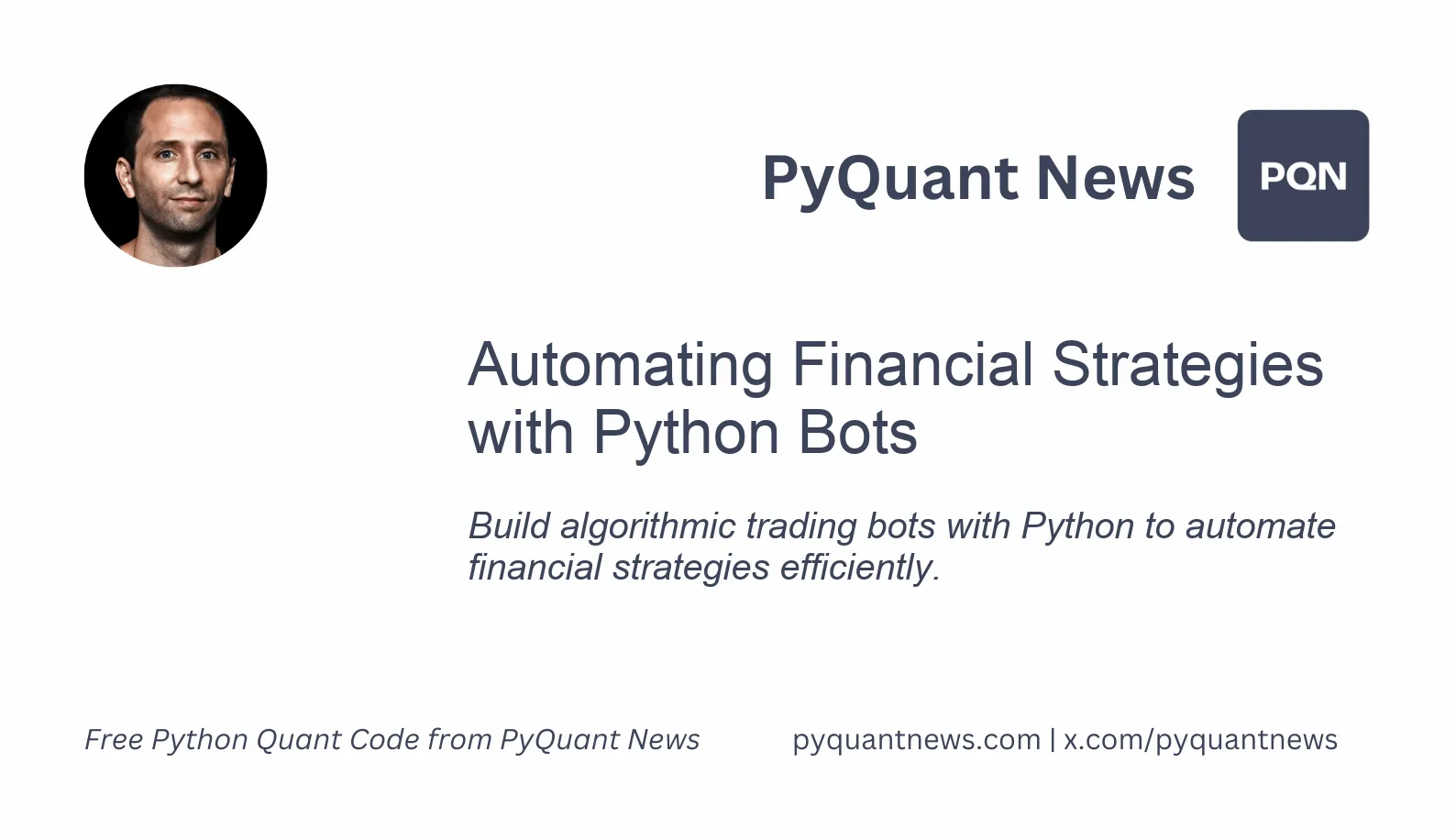Automating Financial Strategies with Python Bots






Automating Financial Strategies with Python Bots
In today's finance world, integrating technology is indispensable. Algorithmic trading, previously reserved for top-tier institutions, is now available to individual traders, thanks to the simplicity and power of Python. This article delves into how to build effective trading bots using Python, covering the essential concepts, tools, and strategies for seamless financial strategies automation.
Understanding Algorithmic Trading
Algorithmic trading, or algo-trading, leverages computer algorithms to execute trades with speed and frequency beyond human capability. These algorithms operate on pre-defined instructions based on factors like timing, price, and quantity. The key advantages of algo-trading include enhanced efficiency, reduced transaction costs, and the elimination of emotional biases in trading decisions.
Why Choose Python?
Python is the preferred language for developing trading bots for several reasons:
- User-Friendly: Python's straightforward syntax is easy for beginners to grasp.
- Rich Library Ecosystem: Libraries such as NumPy, Pandas, Matplotlib, and SciPy are vital for data analysis and visualization.
- Strong Community Support: An active community ensures a constant influx of new tools and libraries.
- Versatile Integration: Python integrates seamlessly with other languages and platforms.
Setting Up Your Environment
Before coding, set up your development environment. Install Python and the necessary libraries using pip for a smooth start:
pip install numpy pandas matplotlib scipy
Consider using Jupyter Notebook for interactive coding and visualization:
pip install jupyter
Data Acquisition
Data is crucial for any trading strategy. Reliable historical and real-time data are essential for backtesting and live trading. Platforms like Alpha Vantage, IEX Cloud, and Yahoo Finance provide financial data APIs. Here’s how to fetch historical data using the yfinance library:
import yfinance as yf
# Fetch historical data for Apple
data = yf.download('AAPL', start='2020-01-01', end='2021-01-01')
print(data.head())
This code fetches Apple Inc.'s stock data from January 1, 2020, to January 1, 2021, using the yfinance library.
Developing Your Strategy
A trading bot's core is its strategy. Common strategies include moving averages, momentum trading, and mean reversion. Here’s an example of a simple moving average crossover strategy:
import pandas as pd
# Calculate moving averages
data['SMA50'] = data['Close'].rolling(window=50).mean()
data['SMA200'] = data['Close'].rolling(window=200).mean()
# Generate signals
data['Signal'] = 0
data['Signal'][50:] = np.where(data['SMA50'][50:] > data['SMA200'][50:], 1, -1)
data['Position'] = data['Signal'].shift()
# Plot the strategy
import matplotlib.pyplot as plt
plt.figure(figsize=(14,7))
plt.plot(data['Close'], label='Close Price')
plt.plot(data['SMA50'], label='50-Day SMA')
plt.plot(data['SMA200'], label='200-Day SMA')
plt.legend()
plt.show()
This example calculates the 50-day and 200-day simple moving averages (SMA) of the closing price and generates trading signals based on their crossover.
Backtesting Your Strategy
Backtesting allows you to test your strategy on historical data to evaluate its performance. The backtrader library is highly effective for this purpose:
import backtrader as bt
class SMACross(bt.SignalStrategy):
def __init__(self):
sma1, sma2 = bt.ind.SMA(period=50), bt.ind.SMA(period=200)
crossover = bt.ind.CrossOver(sma1, sma2)
self.signal_add(bt.SIGNAL_LONG, crossover)
cerebro = bt.Cerebro()
cerebro.addstrategy(SMACross)
datafeed = bt.feeds.PandasData(dataname=data)
cerebro.adddata(datafeed)
cerebro.run()
cerebro.plot()
This code defines a simple moving average crossover strategy using backtrader, adds historical data to the backtesting engine (Cerebro), and plots the results after running the backtest.
Automating Execution
After backtesting and optimizing your strategy, automate the execution using platforms like Alpaca or Interactive Brokers, which provide APIs for live trading. Here’s an example of placing an order using Alpaca’s API:
import alpaca_trade_api as tradeapi
api = tradeapi.REST('APCA-API-KEY-ID', 'APCA-API-SECRET-KEY', base_url='https://paper-api.alpaca.markets')
# Check account status
account = api.get_account()
print(account.status)
# Place an order
api.submit_order(
symbol='AAPL',
qty=1,
side='buy',
type='market',
time_in_force='gtc'
)
This code checks the account status and places a market order to buy one share of Apple using Alpaca's trading API.
Challenges and Considerations
Developing an algorithmic trading bot is rewarding but comes with challenges:
- Data Quality: Ensure the accuracy and completeness of your data.
- Latency: Minimize delays between signal generation and order execution to avoid missed opportunities.
- Risk Management: Implement stop-loss and other risk management techniques to protect against significant losses.
- Regulatory Compliance: Adhere to trading regulations and guidelines to avoid legal issues.
Resources for Further Learning
To enhance your skills and knowledge in algorithmic trading, explore the following resources:
Books
- "Algorithmic Trading: Winning Strategies and Their Rationale" by Ernest P. Chan
- "Python for Finance: Mastering Data-Driven Finance" by Yves Hilpisch
Online Courses
- Coursera: "Algorithmic Trading and Finance Models with Python, R, and Stata Essential Training"
- Udemy: "Python for Financial Analysis and Algorithmic Trading"
Websites and Blogs
- QuantStart: Comprehensive resource for quantitative trading strategies
- Kaggle: Platform for data science competitions featuring financial datasets
Forums and Communities
- QuantConnect: Open-source algorithmic trading platform and community
- Stack Overflow: Platform for coding help and learning from other developers
Libraries and Tools
- Backtrader: Feature-rich Python library for backtesting trading strategies
- Zipline: Open-source backtesting library maintained by Quantopian
Conclusion
Algorithmic trading opens up a world of opportunities for those at the intersection of finance and technology. Python, with its simplicity and powerful ecosystem, is an excellent tool for developing trading bots. By leveraging historical data, crafting and testing strategies, and automating execution, traders can gain a competitive edge. Continuous learning and adaptation are vital to thriving in algorithmic trading.